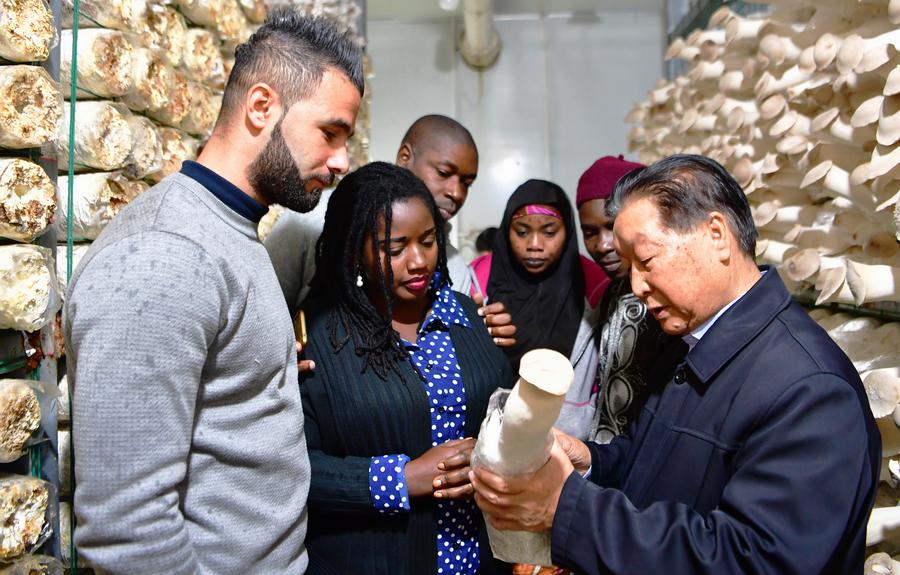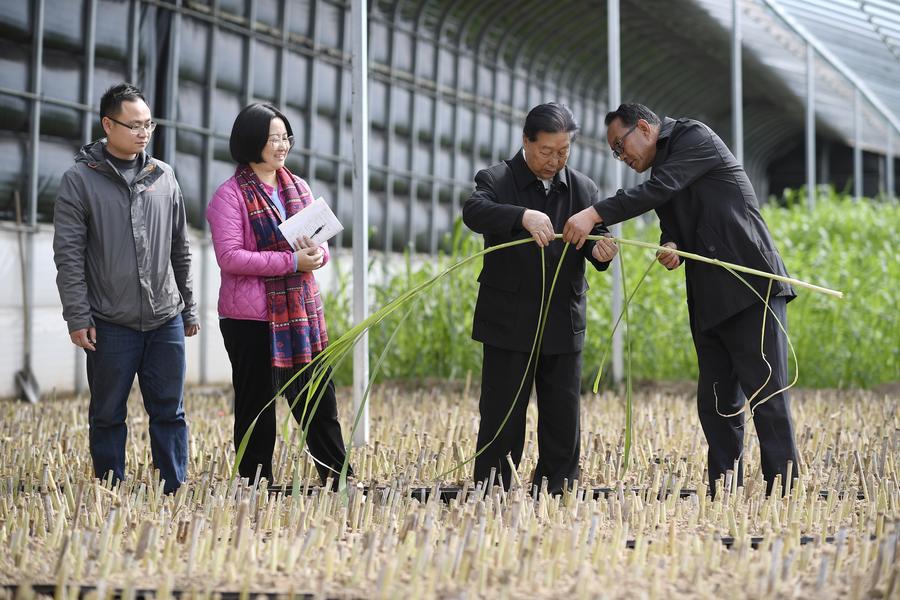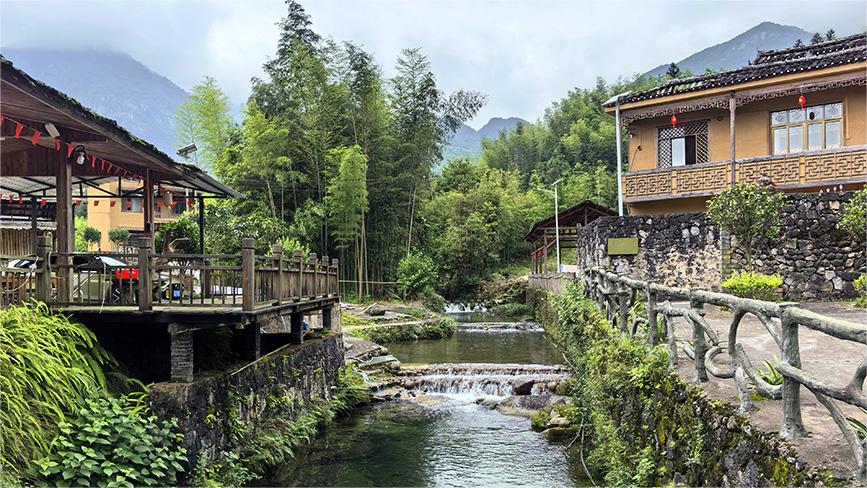How Chinese hybrid grass technology is changing the world for the better

Lin Zhanxi (1st R) from Fujian Agriculture and Forestry University introduces Juncao technology to African students in Fuzhou, southeast China's Fujian Province, Nov. 2, 2018. (Xinhua/Wei Peiquan)
To date, nearly 350 international workshops have trained over 14,000 people in Juncao technology, with introductory papers now available in 18 languages for global use.
"The experimental results were very promising," Professor Lin Zhanxi said. "Juncao is the grass of happiness, a gift from China to all."
KIGALI/FUZHOU, Aug. 27 (Xinhua) -- It was pleasantly warm and dry in Rwanda in early August, and young farmers in Southern Province were celebrating a bountiful harvest. Their hands were not bunched with corn or rice but with mushrooms, cultivated with the help of a technology transferred from a country far away to this "land of a thousand hills" in Africa.
Joining the celebration was Professor Lin Zhanxi. Since the 1980s, the octogenarian scientist has led a research team on Juncao technology in China's southeastern Fujian Province. The hybrid grass technology enables fungi to grow on grass-based substrates instead of felled trees, a solution to the mushroom industry's threat to forests.
The plant's name means "mushroom" and "grass" in Chinese. Its versatility is a key feature, allowing it to grow edible mushrooms, provide livestock feed and help battle desertification.
Thanks to the active and visionary promotion by Chinese President Xi Jinping, Juncao is thriving in and beyond China, improving livelihoods and fostering sustainable development in developing nations across the Asia-Pacific, Africa and Latin America.
A WAY OUT OF POVERTY
Before known as "the father of Juncao," Lin grew up in the impoverished rural mountains of Fujian. His personal experiences with poverty profoundly shaped his commitment to Juncao technology.
After decades of work, Lin and his team succeeded in selecting and breeding a type of high-yield, drought and salinity-resistant herbaceous plant that can be used as a substitute for wood to grow edible and medicinal mushrooms.
At the ninth Aid-for-Trade Global Review Conference held by the WTO in Geneva in June, Lin reflected on how Juncao technology began its global journey. It was back in 1992 when Lin first presented Juncao to widespread acclaim at an international exhibition on inventions, also in Geneva. There in Switzerland, Lin received many calls to learn more about the technology.
Lin recalled how Xi has passionately supported using scientific and technological means to combat poverty.
In 1997, Xi, then deputy secretary of the Communist Party of China Fujian Provincial Committee, listed Juncao technology as part of the province's poverty reduction efforts with the northwestern Ningxia Hui Autonomous Region. Upon receiving the assignment, Lin immediately took his team, as well as grass and fungus seeds, to Xihaigu, a poverty-stricken region in Ningxia.
Today, Juncao technology is used in 31 provinces across China and has significantly contributed to ending poverty and revitalizing rural areas.

Lin Zhanxi (2nd R) exchanges Juncao planting skills with farmers in Minning Town of Yinchuan, northwest China's Ningxia Hui Autonomous Region, March 29, 2021. (Xinhua/Wang Peng)
With Xi's support, a pilot project to introduce Juncao technology in Papua New Guinea was launched in 2000, becoming one of the first applications of Juncao technology overseas.
Fuelled by their dedication and pioneering spirit, Lin and other Chinese researchers have since introduced the technology to 106 countries and regions across the globe.
With a mission to end poverty around the world, Chinese scientists have applied Juncao technology to some challenging environments. In Papua New Guinea's Eastern Highlands, they witnessed tribes still practicing slash-and-burn agriculture. In Rwanda, families without access to cattle or tractors labored in muddy fields using only hoes. In the Central African Republic, they observed the devastating impact of post-conflict famine.
Throughout these years, Lin has faced gunpoint robberies, malaria, altitude sickness and long periods in remote outposts without electricity or water. Witnessing extreme poverty in developing countries further strengthened Lin's commitment to Juncao.
"We go to the poorest places with a genuine intent to help the people," Lin stated.
A PLANT OF PROSPERITY
Agnes Ayinkamiye is the first coordinator of the Juncao project in Rwanda.
"One of the things that made me especially happy was how we helped people. The project was well-received, and we trained many people, particularly women's cooperatives and youth groups," she said. "I enjoyed my work immensely and was thrilled to collaborate with experts."
"People can earn money through Juncao technology, and it's become quite popular," Ayinkamiye added.
Lin noted that around 4,000 Rwandan households have benefited from the technology, with some experiencing their incomes double or even triple over the years.

Lin Zhanxi (R), a professor from China's Fujian Agriculture and Forestry University, visits a mushroom growing shed in Kigali, Rwanda, on Aug. 2, 2024. (Xinhua/Ji Li)
"Juncao technology is affordable ... This technology is applied in such a way that makes it affordable for people at a very local level, which I believe is the key benefit," said Earle Courtenay Rattray, chef de cabinet to the United Nations Secretary-General.
Seruwaia Kabukabu, an entrepreneur in Serea Village of Fiji's Naitasiri Province, is one of the women trained at the Juncao demonstration center in Nadi, Fiji's third-largest city.
"After the training, every one of us received mushroom substrate bags for free from the center. Under the guidance of technical experts, we began to harvest and sell mushrooms within 7-10 days, earning money for our family," Kabukabu said.
The income from the Juncao project allowed her to improve her family's living standards by purchasing essential appliances, building a concrete toilet and bathroom, and even contributing to a clean water project in her community.
"Fiji faces numerous problems ranging from geographical isolation, susceptibility to natural disasters due to climate change that hinders agricultural, and sustainable development and food security," Kabukabu said.
Over the past decade, over 2,400 people in Fiji have received training on Juncao technology, with the Juncao cultivation area in Fiji exceeding 2,000 hectares.
"Simple to learn and effective to implement," said Lin, emphasizing that Juncao technology should lower its technical application threshold abroad "so that even the poorest farmers can get involved."
To date, nearly 350 international workshops have trained over 14,000 people in Juncao technology, with introductory papers now available in 18 languages for global use.
NEVER-ENDING EXPERIMENT
Apart from cultivating mushrooms, Juncao technology has continued to innovate, expanding its production to include feed and fertilizer.
Since using Juncao as fodder, Tahiya Massawe, a farmer in Bumbwi Sudi, Tanzania, has observed improved milk density and nutrition and increased milk production.
"It has also saved money for me," she told Xinhua, "because the budget I previously spent on other feed is now saved by using this grass."
Farmers multiply Juncao and use it on their farms. Many testimonials show that farmers have accepted the technology simply because the feeds are rich, said Makame Kitwana, director of Planning, Policy and Research at Tanzania's agriculture ministry.
"In a number of ways, scientifically, it has (been proven) that the protein content, as well as carbon content, is high, making cattle more satisfied when consuming Juncao grass compared to other grasses," he said.

Nyambo Obed shows the cultivated mushrooms at his workshop near Muhanga in Southern Province, Rwanda, April 6, 2024. (Xinhua/Dong Jianghui)
Juncao can also help with ecological management.
Soil erosion has been a serious problem in countries such as Rwanda. Rwandan officials used to worry that if the soil problem could not be resolved, Rwanda would have no land to cultivate. Lin always kept their concerns in mind.
He still remembers the experimental data in Rwanda during his visit over a decade ago. On one day the rainfall for two and a half hours reached 51.4 millimeters. All the rain was captured by the giant (Juncao) grass, and it was very effective in water conservation and soil retention.
In February in Fiji, Lin also worked on applying Juncao technology to saline soil management, aiming to seek additional solutions to combat climate change for developing countries, including Pacific island nations.
"The experimental results were very promising," Lin said. "Juncao is the grass of happiness, a gift from China to all."
Photos
Related Stories
- Feature: Perseverance is key to success, says Chinese Juncao technology innovator
- China receives high international recognition for contributions to Aid-for-Trade initiative
- Seminar on development of Juncao industry held in Fujian
- Feature: China's "magic grass" benefits Pacific Island countries
- Feature: Chinese-invented Juncao grass changing fortunes of Kenya's dairy farmers
- China's Juncao grass leads to prosperity, happiness
Copyright © 2024 People's Daily Online. All Rights Reserved.









